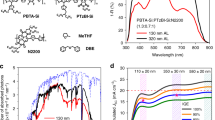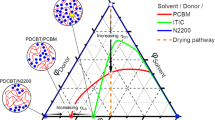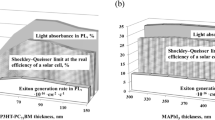Abstract
The efficiency of polymer solar cells critically depends on the intimacy of mixing of the donor and acceptor semiconductors used in these devices to create charges and on the presence of unhindered percolation pathways in the individual components to transport holes and electrons. The visualization of these bulk heterojunction morphologies in three dimensions has been challenging and has hampered progress in this area. Here, we spatially resolve the morphology of 2%-efficient hybrid solar cells consisting of poly(3-hexylthiophene) as the donor and ZnO as the acceptor in the nanometre range by electron tomography. The morphology is statistically analysed for spherical contact distance and percolation pathways. Together with solving the three-dimensional exciton-diffusion equation, a consistent and quantitative correlation between solar-cell performance, photophysical data and the three-dimensional morphology has been obtained for devices with different layer thicknesses that enables differentiating between generation and transport as limiting factors to performance.
This is a preview of subscription content, access via your institution
Access options
Subscribe to this journal
Receive 12 print issues and online access
$259.00 per year
only $21.58 per issue
Buy this article
- Purchase on Springer Link
- Instant access to full article PDF
Prices may be subject to local taxes which are calculated during checkout





Similar content being viewed by others
References
Thompson, B. C. & Fréchet, J. M. J. Polymer-fullerene composite solar cells. Angew. Chem. Int. Ed. 47, 58–77 (2008).
Park, S. H. et al. Bulk heterojunction solar cells with internal quantum efficiency approaching 100%. Nature Photon. 3, 297–303 (2009).
Liang, Y. et al. Highly efficient solar cell polymers developed via fine-tuning of structural and electronic properties. J. Am. Chem. Soc. 131, 7792–7799 (2009).
Huynh, W. U., Dittmer, J. J. & Alivisatos, A. P. Hybrid nanorod-polymer solar cells. Science 295, 2425–2427 (2002).
Wang, P. et al. Photoinduced charge transfer and efficient solar energy conversion in a blend of a red polyfluorene copolymer with CdSe nanoparticles. NanoLett. 6, 1789–1793 (2006).
Kwong, C. Y., Djurisic, A. B., Chui, P. C., Cheng, K. W. & Chan, W. K. Influence of solvent on film morphology and device performance of poly(3-hexylthiophene): TiO2 nanocomposite solar cells. Chem. Phys. Lett. 384, 372–375 (2004).
Kuo, C. Y., Tang, W. C., Gau, C., Guo, T. F. & Jeng, D. Z. Ordered bulk heterojunction solar cells with vertically aligned TiO2 nanorods embedded in a conjugated polymer. Appl. Phys. Lett. 93, 033307 (2008).
Beek, W. J. E., Wienk, M. M. & Janssen, R. A. J. Efficient hybrid solar cells from zinc oxide and a conjugated polymer. Adv. Mater. 16, 1009–1013 (2004).
Beek, W. J. E., Wienk, M. M. & Janssen, R. A. J. Hybrid solar cells from regioregular polythiophene and ZnO nanoparticles. Adv. Funct. Mater. 16, 1112–1116 (2006).
Olson, D. C., Shaheen, S. E., Collins, R. T. & Ginley, D. S. Effect of polymer processing on the performance of poly(3-hexylthiophene)/ZnO nanorod photovoltaic devices. J. Phys. Chem. C 111, 16640–16645 (2007).
Wang, H. et al. Titania bicontinuous network structures for solar cell applications. Appl. Phys. Lett. 87, 023507 (2005).
Ravirajan, P. et al. Hybrid polymer/zinc oxide photovoltaic devices with vertically oriented ZnO nanorods and an amphiphilic molecular interface layer. J. Phys. Chem. B 110, 7635–7639 (2006).
Zhu, R., Jiang, C.-Y. & Ramakrishna, S. Highly efficient nanoporous TiO2-polythiophene hybrid solar cells based on interfacial modification using a metal-free organic dye. Adv. Mater. 21, 994–1000 (2009).
van Hal, P. A. et al. Photoinduced electron transfer and photovoltaic response of a MDMO-PPV: TiO2 bulk-heterojunction. Adv. Mater. 15, 118–121 (2003).
Beek, W. J. E., Slooff, L. H., Kroon, J. M., Wienk, M. M. & Janssen, R. A. J. Hybrid solar cells using a zinc oxide precursor and a conjugated polymer. Adv. Funct. Mater. 15, 1703–1708 (2005).
Moet, D. J. D., Koster, L. J. A., de Boer, B. & Blom, P. W. M. Hybrid polymer solar cells from highly reactive diethylzinc: MDMO-PPV versus P3HT. Chem. Mater. 19, 5856–5861 (2007).
Schilinsky, P., Waldauf, C. & Brabec, C. J. Recombination and loss analysis in polythiophene based bulk heterojunction photodetectors. Appl. Phys. Lett. 81, 3885–3887 (2002).
van Hal, P. A., Christiaans, M. P. T., Wienk, M. M., Kroon, J. M. & Janssen, R. A. J. Photoinduced electron transfer from conjugated polymers to TiO2 . J. Phys. Chem. B 103, 4352–4359 (1999).
Shim, M. & Guyot-Sionnest, P. Organic-capped ZnO nanocrystals: Synthesis and n-type character. J. Am. Chem. Soc. 123, 11651–11654 (2001).
Spano, F. C. Modeling disorder in polymer aggregates: The optical spectroscopy of regioregular poly(3-hexylthiophene) thin films. J. Chem. Phys. 122, 234701 (2005).
Chang, J.-F. et al. Molecular-weight dependence of interchain polaron delocalization and exciton bandwidth in high-mobility conjugated polymers. Phys. Rev. B. 74, 115318 (2006).
van Duren, J. K. J. et al. Relating the morphology of poly(p-phenylene vinylene)/methanofullerene blends to solar-cell performance. Adv. Funct. Mater. 14, 425–434 (2004).
Yang, X., van Duren, J. K. J., Janssen, R. A. J., Michels, M. A. J. & Loos, J. Morphology and thermal stability of the active layer in poly(p-phenylenevinylene)/ methanofullerene plastic photovoltaic devices. Macromolecules 37, 2151–2158 (2004).
Jinnai, H., Nishikawa, Y., Ikehara, T & Nishi, T. Emerging technologies for the 3D analysis of polymer structures. Adv. Polym. Sci. 170, 115–167 (2004).
Shaw, P. E., Ruseckas, A. & Samuel, I. D. W. Exciton diffusion measurements in poly(3-hexylthiophene). Adv. Mater. 20, 3516–3520 (2008).
Piris, J. et al. The locus of free charge-carrier generation in solution-cast Zn1–xMgxO/poly(3-hexylthiophene) bilayers for photovoltaic applications. Adv. Funct. Mater. 17, 3849–3857 (2007).
Becker, H., Burns, S. E. & Friend, R. H. Effect of metal films on the photoluminescence and electroluminescence of conjugated polymers. Phys. Rev. B. 56, 1893–1905 (1997).
Yim, K.-H., Friend, R. H. & Kim, J. S. Anisotropic optical properties in electroluminescent conjugated polymers based on grazing angle photoluminescence measurements. J. Chem. Phys. 124, 184706 (2006).
Markov, D. E. & Blom, P. W. M. Migration-assisted energy transfer at conjugated polymer/metal interfaces. Phys. Rev. B. 72, 161401(R) (2005).
Acknowledgements
The authors gratefully acknowledge D. Veldman for assistance with the PIA measurements and N. Lousberg for preparing a cross-section of a complete device by FIB processing. The research was supported by a TOP grant of the Chemical Sciences (CW) division of the Netherlands Organization for Scientific Research (NWO) and is part of the Joint Solar Programme (JSP). The JSP is co-financed by the Foundation for Fundamental Research on Matter (FOM), Chemical Sciences of NWO and the Foundation Shell Research. This work was further supported by the Deutsche Forschungsgemeinschaft under Priority Programme 1355 ‘Elementary Processes of Organic Photovoltaics’, Senter/Novem in the EOS project Zomer (EOSLT03026) and is part of the research program of the Dutch Polymer Institute (DPI, project 524).
Author information
Authors and Affiliations
Contributions
S.O. made and characterized the devices, S.v.B. did the TEM measurements. R.T. carried out the statistical analysis. L.J.A.K. carried out the exciton diffusion calculations. J.G. did the optical modelling. M.W., J.L., V.S. and R.J. planned the research and supervised it. The article was written by S.O. and M.W.
Corresponding author
Supplementary information
Supplementary Information
Supplementary Information (PDF 534 kb)
Rights and permissions
About this article
Cite this article
Oosterhout, S., Wienk, M., van Bavel, S. et al. The effect of three-dimensional morphology on the efficiency of hybrid polymer solar cells. Nature Mater 8, 818–824 (2009). https://doi.org/10.1038/nmat2533
Received:
Accepted:
Published:
Issue Date:
DOI: https://doi.org/10.1038/nmat2533
This article is cited by
-
Electroactivity of the hybrid material composed of poly(3-hexylthiophene) and titania nanoparticles synthesized by electrochemical process
Bulletin of Materials Science (2022)
-
Enhanced Photovoltaic Performance of Hybrid Solar Cells with a Calcium Interfacial Metal Electrode
Journal of Electronic Materials (2019)
-
In Situ Growth of Metal Sulfide Nanocrystals in Poly(3-hexylthiophene): [6,6]-Phenyl C61-Butyric Acid Methyl Ester Films for Inverted Hybrid Solar Cells with Enhanced Photocurrent
Nanoscale Research Letters (2018)
-
Exciton Diffusion in Organic Nanofibers: A Monte Carlo Study on the Effects of Temperature and Dimensionality
Scientific Reports (2018)
-
Effect of Au nanoparticles on the performance of hybrid solar cells
Microsystem Technologies (2018)



